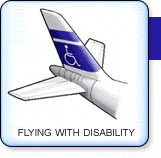|
|
Flying With Disability
| Disabled Travellers - Knowing your rights |
|
Until surprisingly recently, access for disabled travellers onto aircrafts had been notoriously difficult, and emerged as a reoccurring form of embarrassment for the aviation industry as a whole.
A general need for a massive overhaul and improvement to current practices was in dire need, and in 1986 in USA, congress passed the Air Carrier Access Act, which inaugurated the Department of Transportation to develop new rules and regulations to ensure that persons with disabilities will not experience discrimination in 'a way consistent with the safe carriage of all passengers.
Published in March 1990, these regulations, known as the Air Carriers Access, marked a new era in accessible travel for disabled travellers. The Air Carriers Access rules delineate the responsibility of the traveller, carrier, airport, operators and contractors, who together cooperate in the process of flying.
Ultimately, the aim of these guidelines is to minimize those problems a disabled traveller may experience when flying. Flying With Disability refers to these regulations throughout as a means to highlight the rights you may have as a disabled traveller.
To read the original document click here.
British users may find it useful to refer to the Department of Transport's own regulations. These standards set out to protect the rights of disabled travellers to fly closely match those found in the U.S.
The Air Carrier Access rules are set out based on the awareness that the incorporation of new technology and well thought out planning can be used to circumvent and reduce the obstacles flying which a disability can encumber.
By properly training all staff who work within the aviation industry, and alerting them to the needs and assistance the disabled traveller may have. Staff will be equipped with the know-how to quickly and safely enable disabled travellers to fly.
|
|
|
